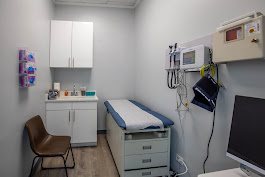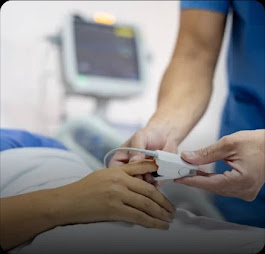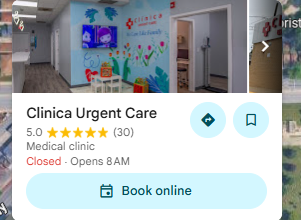Chicago Urgent Care Centers Improve Average Wait Times
Chicago urgent care centers offer faster, more efficient care for non-emergency needs, with most patients seen in 15–45 minutes—much quicker than ERs. Wait times vary by time of day, patient volume, and season, but clinics work to keep delays minimal. Technology like online check-ins also improves efficiency.Clinica Urgent Care in Chicago, IL, provides compassionate, timely service, making it a reliable choice for urgent medical needs.
Chicago, IL, United States, 17th Sep 2025 – When sudden illnesses or minor injuries arise, many people turn to urgent care centers for quick medical attention. Patients often wonder how long they might have to wait before being seen by a provider, especially in busy areas like Chicago. The good news is that urgent care Chicago locations are designed to provide timely treatment for non-life-threatening conditions. Wait times can vary depending on the day, time, and number of patients ahead, but most centers aim to see individuals much faster than a traditional emergency room. Understanding these average wait times helps patients plan for efficient and accessible care.

Average Wait Times at Local Clinics
Visiting a walk-in clinic can be a relief when you need quick care, but the time you spend waiting before being seen is an important factor. Many urgent care Chicago centers report that patients are usually seen within 15 to 45 minutes, which is significantly shorter than the average emergency room wait. The streamlined approach of these clinics helps patients receive treatment for non-critical concerns without unnecessary delays.
Of course, the exact wait can depend on factors like patient volume, time of day, and staff availability. Clinics during early mornings or late evenings may be busier, and weekends are often peak hours. Knowing these patterns helps set expectations for patients who need timely care. While no clinic can guarantee the same wait time every day, most strive to keep delays minimal to provide fast and efficient service.
Factors That Influence Waiting Periods
Several elements affect how long patients may sit in the waiting area before their visit begins. For urgent care Chicago centers, one major factor is patient volume. When more people come in with minor illnesses or injuries, the wait time naturally increases. Another consideration is the severity of cases being treated, as patients with urgent but not emergency-level needs may be prioritized differently.
Staffing levels also play a role. A clinic with more providers on duty is often able to serve patients more quickly than one with a limited team. Additionally, the type of services required can affect timing, as diagnostic testing or special procedures may take longer to arrange. By understanding these influences, patients gain a clearer picture of what to expect when visiting. Planning ahead with this knowledge helps reduce frustration and supports a smoother visit.
Comparing Wait Times with Emergency Rooms
Emergency rooms are often associated with long waits, especially for non-life-threatening conditions. In contrast, urgent care Chicago facilities typically aim to treat patients faster and with fewer delays. On average, ER wait times can extend from one to several hours, depending on the severity of cases and hospital workload. This makes urgent care a more convenient choice for issues such as sprains, infections, or minor fractures.
Patients visiting urgent care not only benefit from shorter waits but also experience a more straightforward process. The environment is less overwhelming, and staff focus on delivering efficient treatment for a wide range of conditions. This difference in approach makes these centers an appealing option for anyone needing medical attention without enduring lengthy delays commonly seen in hospital emergency departments. The convenience continues to attract more patients seeking timely healthcare access.
Peak Hours and Best Times to Visit
The timing of your visit can greatly influence how quickly you’re seen at urgent care Chicago locations. Early mornings and late evenings are often the busiest, as many patients stop by before or after work. Weekends also tend to see heavier traffic, especially when primary care offices are closed. These peak times can lead to longer waits, sometimes stretching beyond the average window.
For those seeking quicker service, mid-mornings and early afternoons on weekdays are generally the best times to visit. During these hours, patient flow is lighter, and staff can usually attend to individuals more promptly. Knowing these patterns allows patients to better plan their visits, ensuring they receive care with minimal delays. Choosing less crowded times not only saves time but also provides a smoother experience overall.

How Staff Efficiency Impacts Wait Time
One of the biggest factors influencing wait length is the efficiency of medical teams. At urgent care Chicago facilities, staff members are trained to handle a steady flow of patients while keeping processes streamlined. From front desk check-in to initial assessments, their ability to coordinate tasks directly affects how quickly patients are seen. A well-organized team can significantly reduce delays in care delivery.
Team collaboration is especially important when balancing a mix of patient needs. For example, staff may need to shift quickly between treating a child with an ear infection and assisting an adult with a sprained ankle. When staff are highly efficient, they help ensure patients move through the process with minimal waiting. This efficiency not only enhances patient satisfaction but also supports the clinic’s ability to handle higher patient volumes effectively.
Patient Preparedness for Faster Visits
Patients themselves can play a role in shortening wait times. When visiting an urgent care Chicago location, arriving with identification, insurance information, and a list of medications can speed up the intake process. Having these details ready allows staff to complete paperwork more quickly, moving patients into exam rooms faster. A prepared patient helps the clinic run more smoothly overall.
Another helpful step is to clearly explain symptoms and provide any relevant medical history upfront. This clarity assists providers in making quicker assessments and reduces the need for repeated questions. Patients who plan ahead not only make their own visit more efficient but also contribute to reducing delays for others waiting. In this way, patient preparedness becomes an important part of maintaining shorter wait times in busy clinics.
The Role of Location in Wait Duration
Not all urgent care Chicago clinics experience the same volume of patients. Location plays a significant role in determining how long you may need to wait. Clinics in densely populated neighborhoods or near busy commercial areas often experience higher patient flow, which can extend wait times. On the other hand, facilities in quieter areas may be less crowded and able to see patients more quickly.
Accessibility also matters. A clinic that’s conveniently located near public transportation or major highways may attract more visitors, increasing patient traffic. While this can lengthen the wait at certain times, it also means these centers are well-equipped to handle a wide range of conditions. Choosing the right location based on convenience and typical patient volume helps individuals balance access to care with expected waiting times.
Seasonal Patterns That Affect Wait Times
The time of year has a noticeable effect on how long patients wait at urgent care Chicago clinics. During flu season, for example, many people visit with symptoms like fever, cough, or body aches, which leads to busier waiting areas. Allergy season can also create spikes in patient numbers, as more individuals seek treatment for respiratory or sinus issues. These seasonal trends increase overall patient volume.
Conversely, some months may be slower, leading to shorter wait times. Summer tends to bring more visits related to sports injuries or outdoor accidents, while winter is busier with respiratory illnesses. Being aware of these seasonal patterns allows patients to anticipate possible delays and plan their visits strategically. While clinics work hard to maintain quick service, external factors tied to seasons naturally influence how long patients must wait.
Technology Enhancements That Reduce Delays
Advancements in healthcare technology have improved the speed of service at many urgent care Chicago centers. Online check-in systems, for example, allow patients to register before arriving, which reduces the time spent filling out forms in the waiting room. Some clinics even provide real-time updates on estimated wait times, helping patients decide when to arrive for the quickest experience.
Electronic health records also play a role in cutting down delays. With streamlined access to patient histories and medications, providers can diagnose and treat more efficiently. Mobile apps and digital communication tools further support quick updates between staff members. These innovations not only reduce waiting but also create a smoother overall experience. As technology continues to advance, patients can expect even shorter waits and more efficient visits in the future.
Conclusion
Shorter wait times make urgent care centers a reliable choice for addressing non-emergency health concerns quickly. By knowing the factors that influence waiting periods, such as peak hours, staff efficiency, and seasonal trends, patients can better prepare for a smooth visit. Clinics that use technology and streamlined systems continue to provide faster, more convenient care compared to traditional emergency rooms.
For those in need of timely medical attention, Clinica Urgent Care in Chicago, IL, is committed to providing efficient and compassionate service. Patients can expect attentive care without the long delays often found elsewhere. If you are dealing with an illness or injury that requires prompt treatment, reach out to Clinica Urgent Care today at (630) 270-3630. Taking the step to visit ensures you receive quality care when you need it most.
FULL BUSINESS NAME: Clinica Urgent Care
BUSINESS ADDRESSED: 8634 S Pulaski Rd, Chicago, IL 60652, United States
WEBSITE : https://clinicaurgentcare.com/
CONTACT NUMBER : +17083616714
Company Details
Organization: Clinica Urgent Care
Contact Person: Clinica Urgent Care
Website: https://clinicaurgentcare.com/
Email: Send Email
Contact Number: +16302703630
Address: 8634 S Pulaski Rd, Chicago, IL 60652
City: Chicago
State: IL
Country: United States
Release Id: 17092534062

